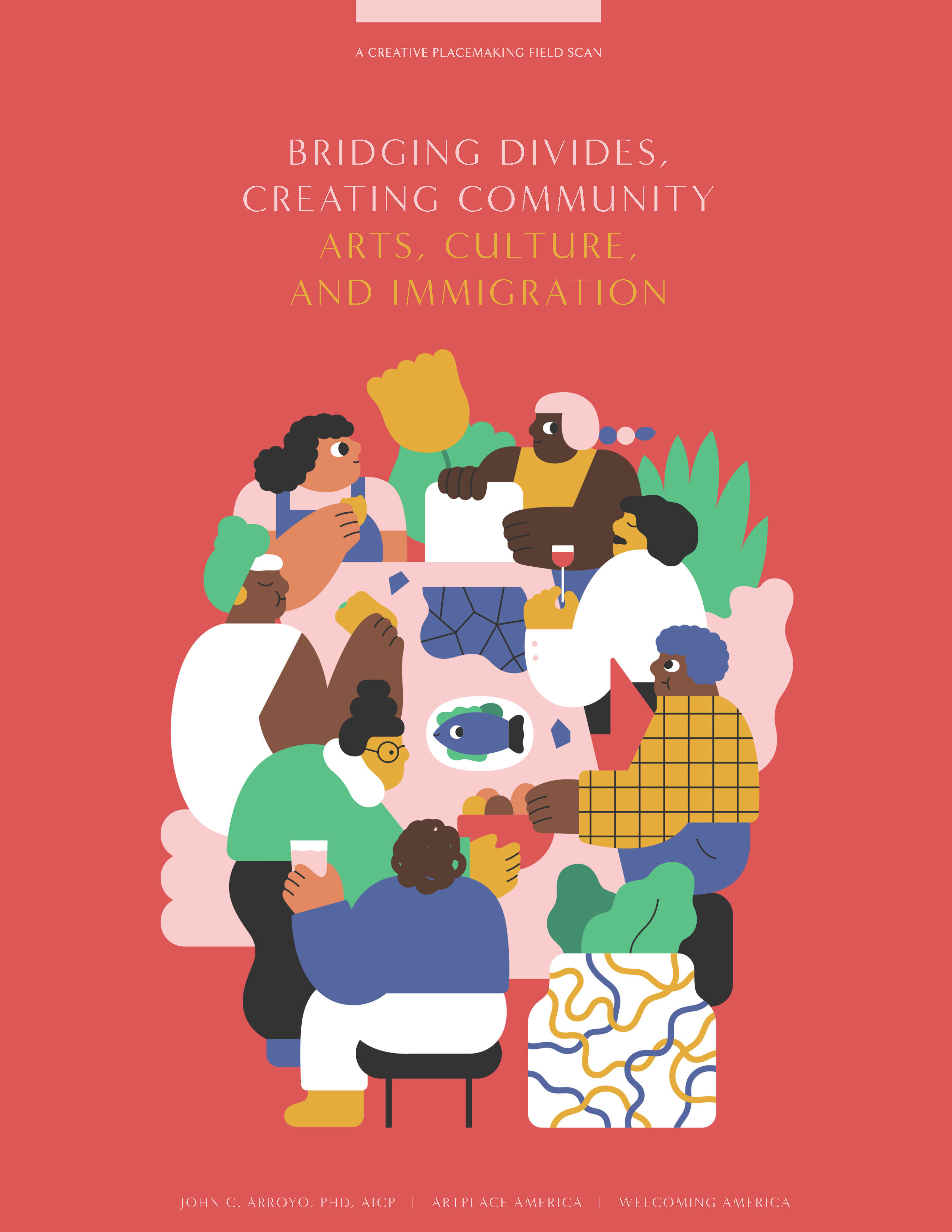Immigration
Introduction
In an effort to identify and foster innovative models of collaboration between the arts and immigration fields, ArtPlace announced a strategic partnership in 2018 with Welcoming America, an organization that works to create more inclusive communities. At a time when the nation faces challenges in bridging divides across lines of difference, this partnership has sought to foster belonging and social cohesion for all Americans by bringing together Welcoming America’s place-based network with the creative community in new ways.
Welcoming America is an international membership organization of 200 nonprofits and local governments working to promote immigrant inclusion and welcoming communities for all. They have set a national standard that outlines the policies and programs at the core of welcoming, and acts as a road map for communities working to be more inclusive of new Americans. Welcoming America’s deep national and local knowledge of immigration and refugee technical assistance, policy advocacy, and convening makes them a natural fit for this collaboration.
As the conveners and facilitators of the Arts, Culture, and Immigration Working Group in May 2019 in Pittsburgh, PA, ArtPlace and Welcoming America brought together over 30 national experts in arts and culture, community development, and the immigration sector to discuss strategies for advancing existing knowledge and practice at this intersection.
Through scholarships for artists to attend the annual Welcoming Interactive, pilot programs to test arts-driven welcoming plans, and more, Welcoming America will continue to explore and scale innovative models for creative placemaking and arts programming to support immigrant incorporation and welcoming initiatives, and to engage artists and cultural institutions in local communities to help shape a more inclusive America.
Field Scan
In 2018, ArtPlace commissioned John Arroyo, Ph.D., AICP to lead an exploration of the intersection of arts, culture, and immigration. Arroyo’s research was conducted primarily through a comprehensive literature review; an analysis of 140 creative placemaking projects; and semi-structured, in-depth interviews with 30 practitioners working in the immigration or arts and cultural sectors. External review and revisions were provided by the working group, held in May 2019, and by our partners at Welcoming America.
This investigation captures the voices and insights of artists and immigration professionals working on a wide range of advocacy and social service issues in the face of rapidly changing mobility patterns in the U.S. and globally. Through his analysis of both immigration sector priorities and place-based arts and cultural work, Arroyo uncovered four primary strategies by which arts and culture are helping to meet immigration sector goals. Arts and culture can:
- Bridge Newcomers and Longer-Term Populations
- Elevate Cultural Traditions as Assets
- Engage Newcomers and Other Allies in Civic Processes
- Co-Create Spaces that Reflect Identity
Download the full field scan, Bridging Divides, Creating Community: Arts, Culture, and Immigration, to learn more about the power that creative placemaking holds for those working to create an America where everyone – including immigrants and refugees – can belong and thrive.
Field scan design by MESH Design and Development; illustrations by Jing Wei.
Working Group
Co-convened by ArtPlace America and Welcoming America
Amy Herzfeld-Copple, Western States Center
Ashley Hanson, Department of Public Transformation and PlaceBase Productions
Betty Cruz, All for All
Bryan Warren, Office for Globalization, Louisville Metro Government
Carolina Rubio MacWright, TouchingLand.org
Christa Yoakum, Nebraska Is Home
Christina Patiño Houle, Las Imaginistas
Cooper Green, Interfaith Mission Service
Cynthia Woo, Pao Arts Center, Boston Chinatown Neighborhood Center
Dan Wallace, New American Economy
David Flores, Casa Familiar
Hazami Sayed, Al-Bustan Seeds of Culture
Henry Reese, City of Asylum
Janera Solomon, Kelly Strayhorn Theater
Jennifer Novak-Leonard, Northwestern University
John Arroyo, University of Oregon
Laura Marcus Green, Ph.D., South Carolina Arts Commission and University of South Carolina
Lynnette Tessitore, City of Chula Vista
Malik Gillani, Silk Road Rising
Mara Kimmel, Anchorage Museum
Nadia El-Zein Tonova, ACCESS
Onye Ozuzu, College of the Arts, University of Florida
Rachel Strutt, Somerville Arts Council
Ryan M. Eller, Define American
Taryn Higashi, Unbound Philanthropy
Ze Min Xiao, Mayor's Office for New Americans, Salt Lake County
Case Studies
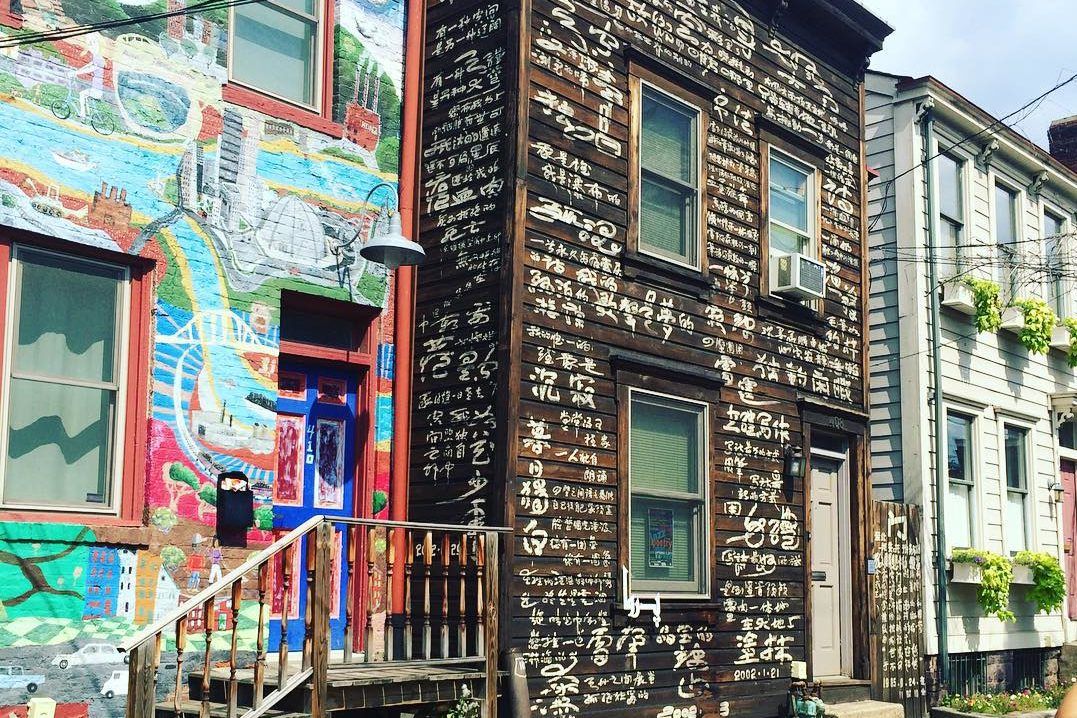
Photo courtesy of City of Asylum
City of Asylum Pittsburgh is a cross-cultural literary arts organization that provides sanctuary to a network of creative writers who have previously been silenced through the threat of persecution, imprisonment, or death in their native countries. It was opened in 2004 by co-founders Henry Reese, a businessman, and Diane Samuels, an artist. City of Asylum @ Alphabet City, its cultural center, bridges newcomers and longer-term populations by using the literary arts as vehicle to highlight the stories of exiled writers among longstanding groups interested in broader cultural exchange. In addition to literary events, City of Asylum hosts 60 jazz concerts and screens over 30 film events annually.
City of Asylum Pittsburgh is currently one of the only U.S. branches of the 60-city International Cities of Refuge Network (ICORN). Writers and their families are provided tailored support services that include a restored house on Sampsonia Way, a stipend, medical benefits, travel expenses to the U.S., legal services, and direct support of their specific literary creative endeavors (commissioning translations, identifying publishers, or providing adaptation support for family members).
Apart from cross-cultural exchange, City of Asylum acts as a driver of local economic development by transforming abandoned and neglected homes in Pittsburgh’s Northside neighborhood into creative cultural spaces with text-based public art. What separates City of Asylum from other writer’s residency programs is its commitment to helping writers reclaim their lives and adapt to a new host society where persecuted writers are free to express themselves. Long-term support continues after a writer’s two-year residency has concluded with, for example, rent-free housing that has no term limit.
City of Asylum’s first program launched when Chinese poet Huang Xiang covered his Sampsonia Way residence with Chinese calligraphy of his poems – soon to be known as “house publications.” The project came to be known as “House Poem,” and elicited an overwhelming response from neighbors and visitors who began to exchange poems with Xiang or attended Xiang’s poetry readings. “House Poem” set the stage for the future of City of Asylum: a street-wide network of multiple restored homes on Sampsonia Way, simultaneous artists in residence, and a growing series of house publications that transformed neighborhood facades into a public library. In 2005, a year after opening, City of Asylum added their Jazz Poetry Concert as a way to pair music with the literary arts. In 2006, City of Asylum added monthly readings with non-resident international authors. In 2007, more programs flourished under the Writers in the Gardens program, and short-term Visiting Writer Residencies. Other programs include the Sampsonia Way publication, an online journal of free speech, and a Sister Cities exchange program with Belgium.
In 2016, City of Asylum developed Alphabet City, a permanent home for small-scale literary and jazz programs, offices, a bookstore, and an affordable restaurant. In 2013, the organization completed Garden to Garden Artway, two distinct pathways programmed with a new series of temporary and community-based residencies in renovated vacant properties, including the Alphabet Reading Garden. The Artway has launched new partnerships for City of Asylum, including with Cave Canem Poets and Greater Pittsburgh Art Council’s Office of Public Art. “Culture doesn’t have to be intimidating. Writers lose their identity when they come [to the U.S.],” commented Reese. “They’re alienated from their language, their country. In addition to establishing your career path as a writer, you’re also trying to re-establish your identity. City of Asylum helps them access this.”
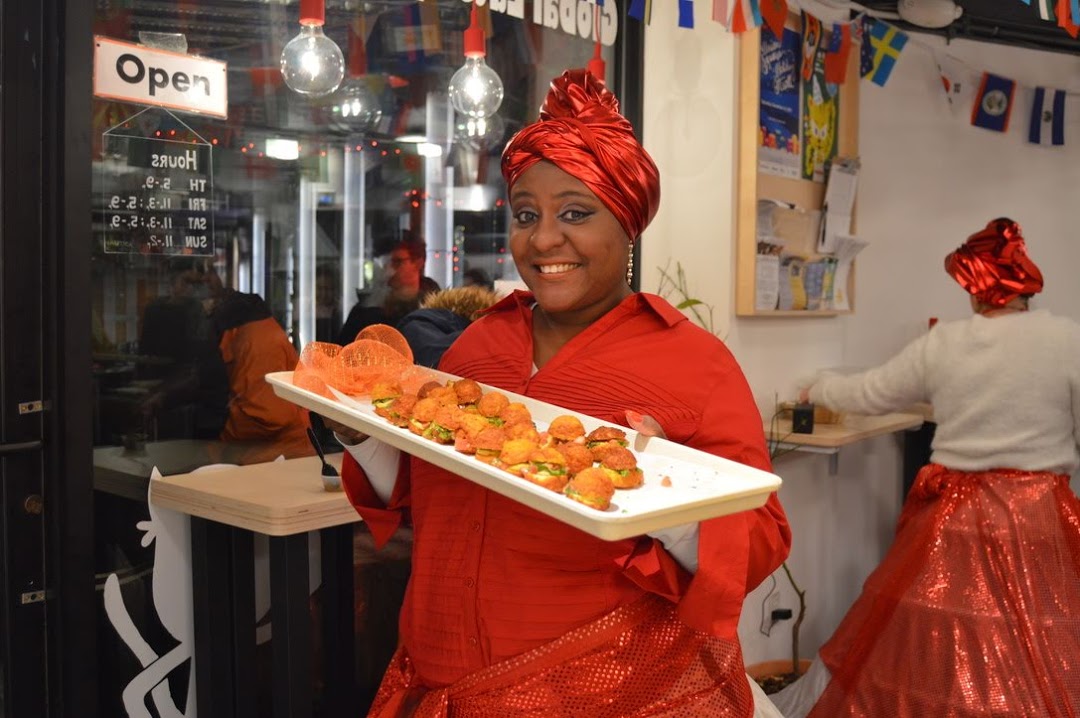
Photo by Maria Fernanda Martínez, courtesy of Somerville Arts Council
Nibble is the culinary entrepreneurship arm of the Somerville Arts Council. Through food tourism in the form of cooking classes, international market tours, pop-up restaurants, and a blog, the program celebrates the diverse food and cultural landscape of the Union Square neighborhood of Somerville. Nibble elevates cultural traditions by helping educate and empower immigrant and refugee culinary entrepreneurs to share their diverse foodways and establish economic empowerment in the local restaurant industry.
Union Square is an evolving area, and is currently experiencing intense urban development due to the planned extension of the Massachusetts Bay Transit Authority (MBTA)’s Green Line. It is also a populous immigrant and refugee area that is home to international markets and ethnic restaurants ranging from Brazilian to Bengali; from Peruvian to Portuguese. These restaurants ground visitors and tourists in an experience of the area’s diverse communities, while also serving as a touchstone to convene and preserve the culinary traditions of local immigrant communities. Because every culture has culinary traditions, food can be a place-based platform for common ground.
Nibble is one component of a larger cultural development initiative. Its signature element is the Nibble Entrepreneurship Program (NEP), an eight-week program that provides emerging immigrant culinary entrepreneurs training to launch their culinary careers. Launched in 2015, the program’s inaugural participants included cooks from Brazil, Mexico, Colombia, Venezuela, India, and Somalia. The program distinguishes itself from other culinary entrepreneurship programs because it provides skills training while allowing members to share their stories and talents with each other and through cooking classes with the public (demos at festivals, pop-ups). Culinary entrepreneurs learn about price points, permitting, employee training, business development, restaurant hospitality, and restaurant safety (through ServSafe certification). The fee is $100 and new participants may join on a rolling basis. To curb uneven development in Union Square, the NEP works to rotate graduates in temporary (pop-up) or permanent (restaurant) spaces in the neighborhood.
Nibble has recently embarked on Nibble Catering as another revenue-generating element, and in October 2019 a fixed Nibble Kitchen opened in Union Square, complete with rotating cuisines including Brazilian, Ethiopian, Bolivian, and more. “Our Nibble community has become this tight-knit community. I think they’re so proud that we’re asking them to share their culture, and they’re excited to have an opportunity to share their culture through food,” commented Rachell Strutt of the Somerville Arts Council. The book Nibble: Exploring Food, Art & Culture in Union Square includes over 25 recipes and cultural stories from many of the culinary entrepreneurs that have participated in the program.
Programs such as Nibble have been successful in revealing the needs of immigrants and refugees in transitory communities. For example, the NEP has revealed that ethnic entrepreneurs struggle with speaking English, which makes it difficult to communicate between customers and kitchen incubators. As a result, participants in the NEP must be enrolled in an ESL class or program. Access to transportation was surfaced as another issue. When students do not have a car, the burden of driving students to meetings or transporting their cooking supplies fall on Nibble staff. In order to empower participants to support themselves, Nibble factors the cost of taxis into business plans. As more generations go through the program, Nibble staff will pair alumni with new participants for peer-learning and mentoring sessions.
Funded by the Somerville Arts Council (ArtsUnion), the Massachusetts Cultural Council, City of Somerville, and ArtPlace America, other key partners for Nibble include SomerViva (the city’s multi-lingual communications department) and Accion (the city’s multi-lingual communications department). Nibble promotes inter-cultural exchange by helping communities understand the inherent assets that immigrants and refugees bring with them, while helping sustain their economic well-being in the process.
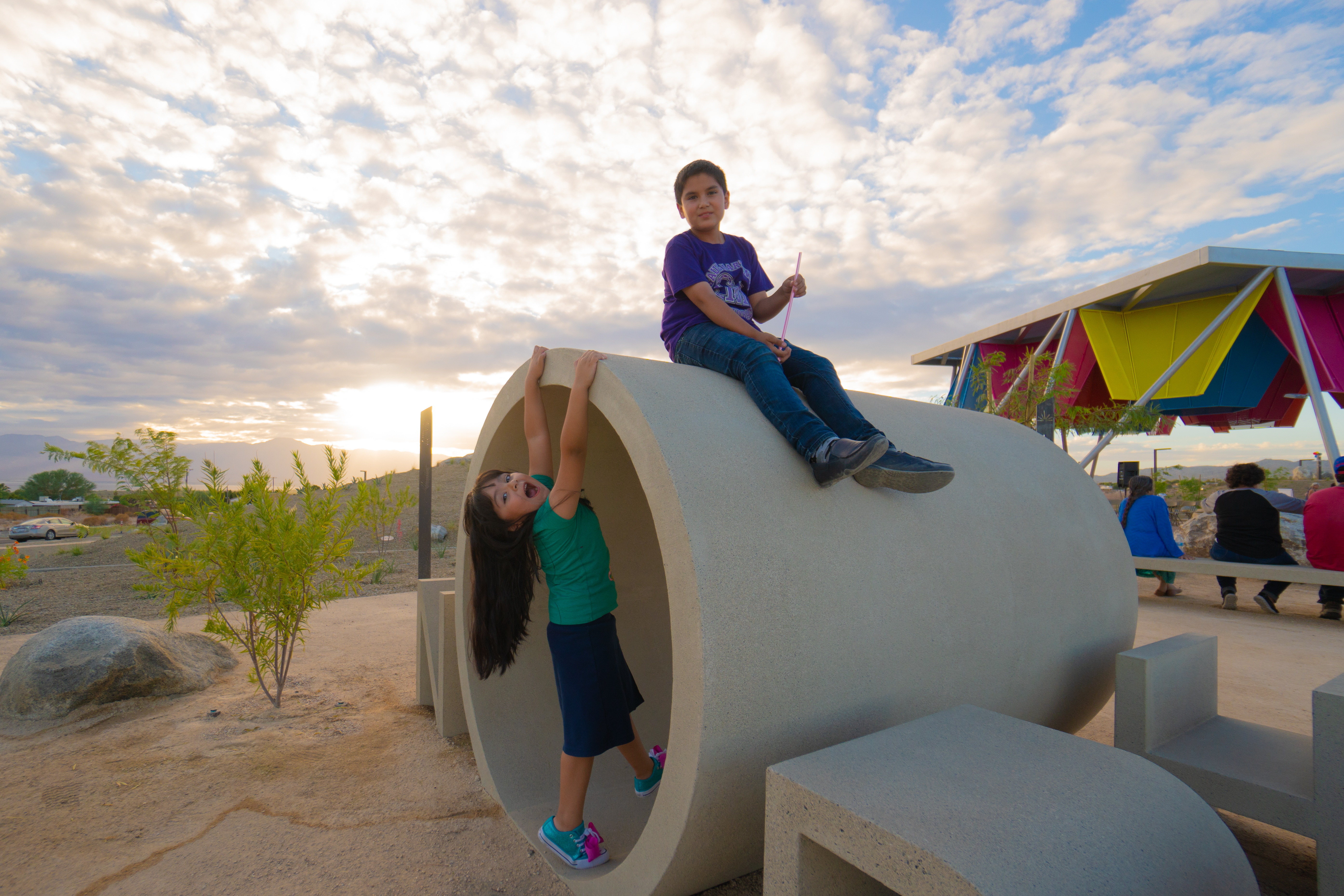
Photo by Studio Loz Feliz, courtesy of KDI
Kounkuey Design Initiative (KDI) is socially-engaged design and community development organization committed to supporting the physical and social improvement of underserved communities. Established in 2006 by six students at the Harvard Graduate School of Design, the founders of Kounkuey (the Thai word for “getting to know”) realized the future of design relied on community members as co-authors in the design process. Based in Los Angeles with an office in Kenya, KDI has worked on participatory planning projects in the U.S., Africa, and Latin America. KDI draws on an arsenal of expertise from architects, landscape architects, engineers, urban planners, and community organizers to position the communities they serve at the center of their projects from start to finish. KDI increases access to resources and builds connections between public and private actors by using social design techniques to create “productive public spaces” in underserved areas – public spaces that address the economic and social conditions of the area.
One of KDI’s ongoing projects is located in California’s North Shore, an unincorporated area of Riverside County adjacent to the Salton Sea. With a population of 3,500, the rural area is comprised of a predominantly seasonal Mexican agricultural community in the Eastern Coachella Valley. Once a popular tourist destination for boaters during the 1960s and 70s, the area fell into decline due to the high salinity in the Salton Sea and failed attempts to revive tourism. The negative perception of the area is pervasive; it is fueled by poverty and a lack of basic civic services and infrastructure, including schools, transportation, grocery stores, and parks.
In 2013, KDI began to work with residents and community activists to design the area’s first public space – a way to connect residential areas. Through the support of Riverside County’s Desert Recreation District, what was intended to be less than an acre soon became a five-acre public park. Multimedia designer Shannon Scrofano and artist Evelyn Serrano engaged community members by leading a cultural asset mapping exercise, one that would uncover local creativity and inform “situaciones” – site-specific cultural interventions for inter-generational outreach. Other programs include a teen-produced, DIY news program called the “The Salty Bottom Show;” a bi-monthly, bi-lingual print and online community newspaper about local history and community development titled El Progreso; support of Delicias Laguna Azul, a local women’s culinary entrepreneurship program connected to a new farmer’s market; and Desert Riderz, a bike co-op.
“The North Shore and communities like it are often times not credited for the work or the momentum they’ve established. Communities and individuals are not just waiting for someone to come solve the problem for them,” said Chelina Odbert, Co-founder and Executive Director, Kounkuey Design Initiative. “They are actively trying to solve the problem in the best way that they know how. We are just trying to help them reach whatever goal they have.” The park broke ground in spring 2016 and opened in September 2016. The park includes kiosks for vendors, picnic areas, a skate park, shaded pavilions for gathering, community-designed artwork, and the area’s first athletic (soccer) fields.
Apart from community-informed civic improvements, another one of Nuestro Lugar’s key benefits has been its ability to bring critical resources and funding to the North Shore. With grants from The California Endowment, Surdna Foundation, the National Endowment for the Arts, and ArtPlace America, resources include new and expanded public space, a farmer’s market, place-based public art, transportation infrastructure in the form of a bicycle sharing program, and a resident-led cultural council called the North Shore Arts Committee. Perhaps the strongest sustained effort to creatively increase access to previously unavailable resources has been securing funding from the County of Riverside and State of California. Prior to Nuestro Lugar, the state and county had not committed any funds to support water and transportation infrastructure in the area. As the number of immigrants grew in the unincorporated area of the North Shore, the need for water and transportation infrastructure became essential to satisfy basic quality of life needs. Each of these elements has given shape to a new, empowered narrative for community members of North Shore.
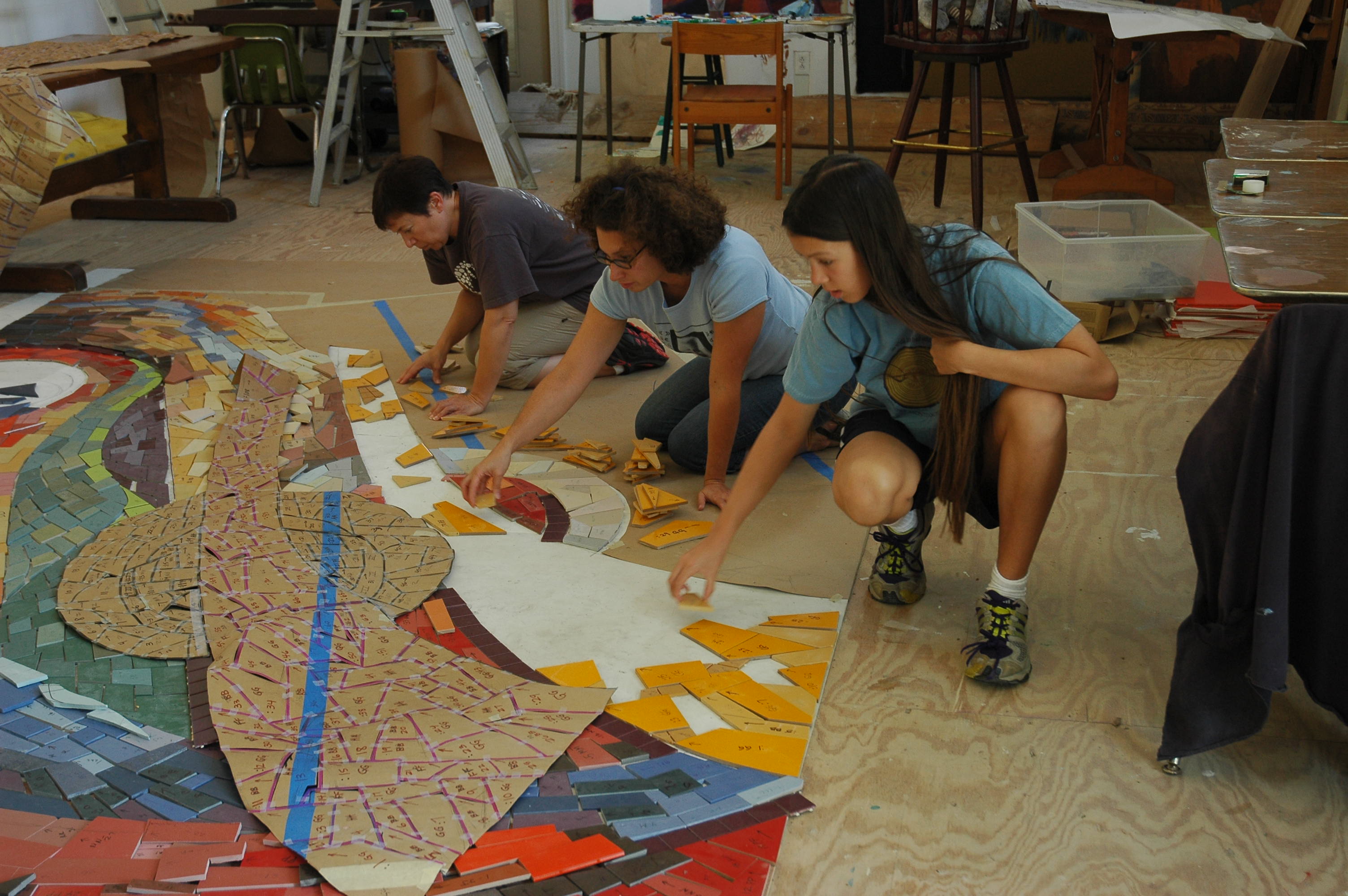
Photo by Prado Studio
Casa Azafrán is an immigrant services complex located in downtown Nashville, one of the fastest-growing urban centers of new immigration in the U.S. The complex is a one-stop shop for a network of leading immigrant-serving non-profit organizations, with education, legal, health care, and arts and culture services as well as an event space. Opened in 2012, the complex was a project of Conexión Américas, one of Nashville’s largest immigrant social service centers. Today Casa Azafrán is credited with revitalizing its immediate neighborhood, increasing collaboration among like-minded non-profit organizations, and providing services for new and existing populations through education, health services, fitness, entrepreneurship training, culinary and artistic expression, community events, and financial services. Casa Azafrán employs arts and culture by hosting collective community arts projects that welcome and connect patrons to a network of critical immigration services benefitting Nashville’s new American community.
Conexión Américas purchased its 28,800 square-foot building in 2011 in South Nashville’s Nolensville Pike corridor – the gateway to Nashville’s most diverse district. The main entranceway to Casa Azafrán is enhanced by “Migration,” a 30-foot by 12-foot mosaic mural that includes more than 7,000 pieces of hand-cut tile, incorporating the work of over 350 volunteers over a two-year timeline. Migration was created by Jairo Prado (a Colombian native living in Nashville for over 35 years) and his wife, Susan Prado. Representing the migration story of people across the world, the project was “built by Nashville, for Nashville” during open studio sessions in the Prados’ studio during which community members shared and illustrated their migration stories. The collaborative process allowed volunteers of all skill levels and ages to commemorate their experiences. According to Jairo Prado, “The success of the mosaic is its ability to engage – both immigrants and refugees embraced the idea, and the mosaic-making process helped immigrants carve a space of their own in the community, to become a larger part of the community. Each piece represents one unique story that contributes to the whole composition of the city. I feel that art is one of the best ways to strengthen the community.” When the project was finished, the mosaic was transported to Casa Azafrán, where it was re-assembled, hoisted up two stories, and installed on the façade of the Moorish and Spanish style building.
The project was funded in part by the Tennessee Arts Commission and the National Endowment for the Arts, as well as a local crowdfunding campaign for $25,000. It has quickly become a Nashville landmark. “We’re the artists that are advocating for a bridge and for a way of shedding a positive light on the good attributes of what it is to be a diverse community – one that embraces the beauty and the richness of all of the cultures that are present here. We see that our mosaic has become the emblem of the work that the organization [Conexión Américas], and all the organizations who live there, are doing to advocate for people on an individual level,” said Susan Prado. To date the Prados have completed a variety of community-based projects in partnership with the organization over a 10-year period, including mixed media cultural/folk art installations, painted murals, and two large-scale mosaic tile murals (Camino y Raíces/Roots & Routes) – one of which incorporated coins from 99 international countries – for the newly opened public park adjacent to Casa Azafrán.






